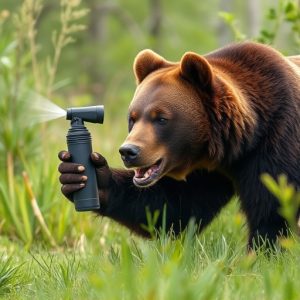Wilderness Defense Against Grizzlies: Bear Spray Secrets and Safety Beyond
Bear spray, a non-lethal defense against grizzly bears, contains capsaicin and other irritants that…….
Bear spray, a non-lethal defense against grizzly bears, contains capsaicin and other irritants that temporarily impair the bear's senses. Effective usage involves understanding the chemicals, aiming for the face and eyes, deploying at close range, and following proper activation techniques. While powerful, bear spray should complement noise-making, group travel, and secure food storage for comprehensive safety in bear habitats. Knowing what chemicals are in bear spray enhances its utility as a game-changer in potential encounters with these wild animals.
In the vast wilderness, encountering a charging grizzly bear is a frightening possibility. However, armed with knowledge and the right tools, human-bear conflicts can be minimized. This article delves into effective strategies for self-defense against grizzly bears, focusing on the cornerstone tool: bear spray. We explore its chemical composition, including what chemicals are in bear spray, and provide essential tips for optimal use. Additionally, we discuss beyond bear spray safety measures for comprehensive wilderness protection.
- Understanding Bear Spray: The Chemical Composition and Its Efficacy
- Effective Use Strategies: Application Techniques for Optimal Protection
- Beyond Bear Spray: Additional Wilderness Safety Measures Against Grizzly Bears
Understanding Bear Spray: The Chemical Composition and Its Efficacy
Bear spray, also known as bear repellent, is a crucial tool for individuals venturing into bear country. Understanding its chemical composition and effectiveness is essential for safety in the wilderness. The primary active ingredients in most bear sprays are capsaicin, the same compound that gives chili peppers their heat, and various other irritants. These chemicals are designed to cause discomfort and temporarily disable a bear’s sense of smell and vision, allowing the user time to escape or defend themselves.
The effectiveness of bear spray lies in its ability to create a barrier between the user and the bear by disrupting the animal’s behavior. When sprayed directly into a bear’s face, capsaicin irritates the eyes, nose, and throat, while other ingredients can cause skin irritation. This combination triggers a reaction in the bear, often causing it to retreat or become distracted, providing a critical window of opportunity for the person to evacuate the area safely. The specific chemical compositions vary among brands, but their common goal is to provide a non-lethal means of self-defense against aggressive bears.
Effective Use Strategies: Application Techniques for Optimal Protection
When it comes to defending against charging grizzly bears, bear spray is a highly effective tool. However, its success hinges on proper application techniques. For optimal protection, individuals in wilderness areas should understand what chemicals are in their bear spray and how to deploy them effectively.
Target the bear’s face and eyes specifically. Aim high and remember that wind direction plays a significant role. Hold the canister upright and activate it at close range, about 20-30 feet away. A good rule of thumb is to “point, aim, pull” – point the spray towards the bear, keep your eye on its target, and then pull the trigger firmly. Effective use requires practice, so consider training with a professional to ensure you’re ready for any encounter.
Beyond Bear Spray: Additional Wilderness Safety Measures Against Grizzly Bears
When venturing into grizzly bear country, relying solely on bear spray isn’t enough. While this deterrent can be effective when used correctly, it’s crucial to understand its limitations and employ a multi-layered approach for maximum safety. Beyond the chemicals in bear spray – typically capsaicin, which irritates the bear’s eyes, nose, and throat – there are several other measures you can take to protect yourself from these formidable predators.
First, make noise as you navigate through potential bear habitats. This helps bears identify your presence and may deter them from approaching. Carrying and knowing how to use a loud whistle or bearing a noisemaker can be lifesaving. Additionally, traveling in groups increases visibility and reduces the risk of unexpected encounters. Lastly, properly securing food and waste can prevent bears from being attracted to your campsite or trailside rest spots.
When navigating wilderness areas known for grizzly bear populations, prioritizing safety is paramount. Beyond physical barriers and noise-making devices, bear spray stands as a reliable ally. Comprehending its chemical composition, such as capsaicin and pepper-based agents, empowers hikers to make informed choices. Efficient application techniques, like aiming low and following wind direction, ensure its effectiveness. While no single method offers complete protection, combining bear spray with awareness, noise, and distance maintenance significantly reduces risk. Incorporating these strategies into your wilderness kit and mindset is key to a safer adventure among grizzlies.


